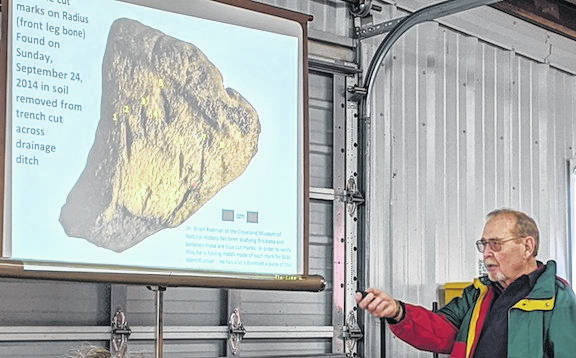MOUNT GILEAD — Headwaters Outdoor Education Center overflowed with children and families for the March 15 event “Diggin’ The Past.”
The speaker was Clint Walker who brought a display of photos and pieces of Mastodon bones and teeth found on his farm on U.S. 42 south of Johnsville.
Walker fascinated the crowd with some of the archeological history of the Mastodon that is believed to have died about 12,000 years ago.
He described the stages of the dig from the day he discovered a tooth on a mound of dirt that was left from digging a waterway on his farm. Walker’s property lies by a creek and this find was in an area that sometimes gets swampy during the spring.
After looking at information on the Internet, Walker called the Ohio History Connection and Dr. Nigel Brush, a professor of geology at Ashland University, got involved. Brush came with volunteers and students to set up and work on the dig.
The first discovery was in 2014. Since then Dr. Richard M. Gramly of Harvard University and archeology students and professors from several universities in Ohio and numerous other states have come to participate and observe the dig.
Walker said some of the most dedicated local people working at the dig were Mya and Joanne Trainer, Marilyn Weiler and Jerry Ball.
Mya, a Northmor student, talked about what things she found most interesting at the dig.
“I learned about the tools Indians used and how bones were in certain places and the reason for the condition of the bones,” Mya said.
Mya was most excited about a “stag moose tooth” she found at the dig one day. She said it is the first of its kind found on a United States dig.
“Several thousand pieces of Mastodon bones were found at the site,” said Walker who was manager of plant engineering at Tappan for many years. “Some 65 people worked there to find these pieces.”
A lab at Ashland University sorted, processed and packaged all the pieces. The Natural History Museum in Cleveland wanted the findings. However, Walker decided to keep them in Morrow County.
After describing the world where the Mastodon lived, Walker spoke about conclusions from the find called “Cedar Creek Mastodon:”
• The Mastodon died 12,000-13,000 years ago.
• Size of bones indicates it was a male.
* Cut marks on the bones indicate it was butchered by Paleo Indians.
• Wear on teeth indicates it was 40 years old.
• Soil strategy suggests that a flash flood covered the area 1,500 years ago.







